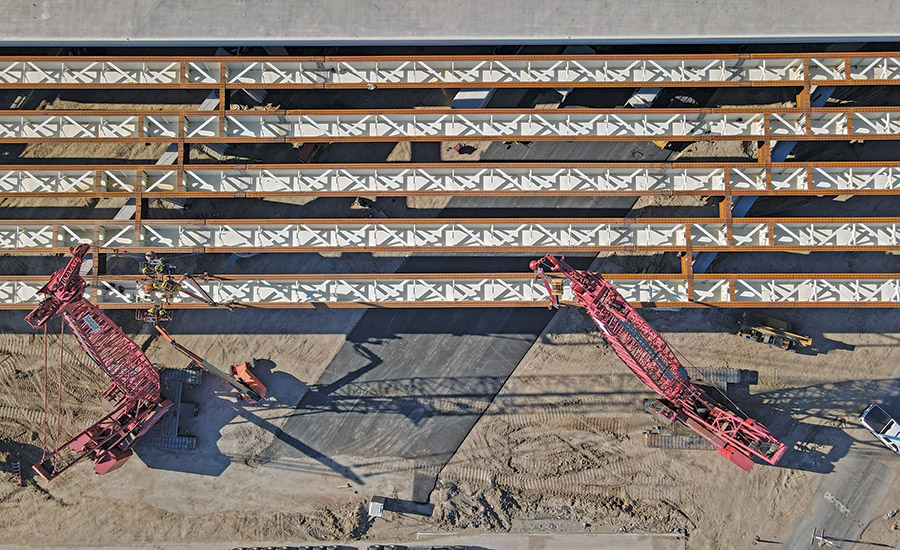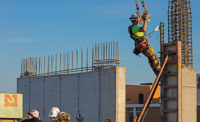The top 100 firms represented on ENR Texas & Louisiana’s 2022 Top Contractors ranking reported a combined $44.96 billion in regional revenue for 2021, down slightly from the $45.59 billion reported by the top 100 firms for 2020. While contractors across the five-state region of Arkansas, Louisiana, Mississippi, Oklahoma and Texas are seeing plentiful work, they share the broader industry’s concerns on supply chain woes, material shortages and inflation, as well as ongoing labor shortages.
Related Link:
ENR Texas & Louisiana 2022 Top Contractors
A total of 109 firms are included on this year’s ranking, 42 of which showed declines in regional revenue for 2021. Of the 109, 21 firms are new participants for this year’s ranking. Available data averages out to show roughly half of the companies ranked reported revenue declines in 2021.
One of those was Houston-based S&B Engineer and Constructor Ltd., which saw regional revenue fall by about $589 million, to tally $952 million for 2021, primarily due to the pandemic, says David Taylor, S&B’s president and COO.
“We had over a billion dollars’ worth of awarded projects get canceled due to COVID and the economic uncertainty that surround the pandemic. Since late last year we’ve seen a resurgence in project activity and a return to pre-COVID revenues,” he says. Recent project wins in the petrochemical, power, manufacturing and hydrogen production markets should help boost revenues, Taylor adds
Tulsa-based Manhattan Construction Group saw a $343-million drop in regional revenue in 2021, posting $794 million for the year. The firm completed several megaprojects in 2020, including Globe Life Field in Arlington, the I-630 Interchange in Little Rock and the John Kilpatrick Turnpike in Oklahoma City.
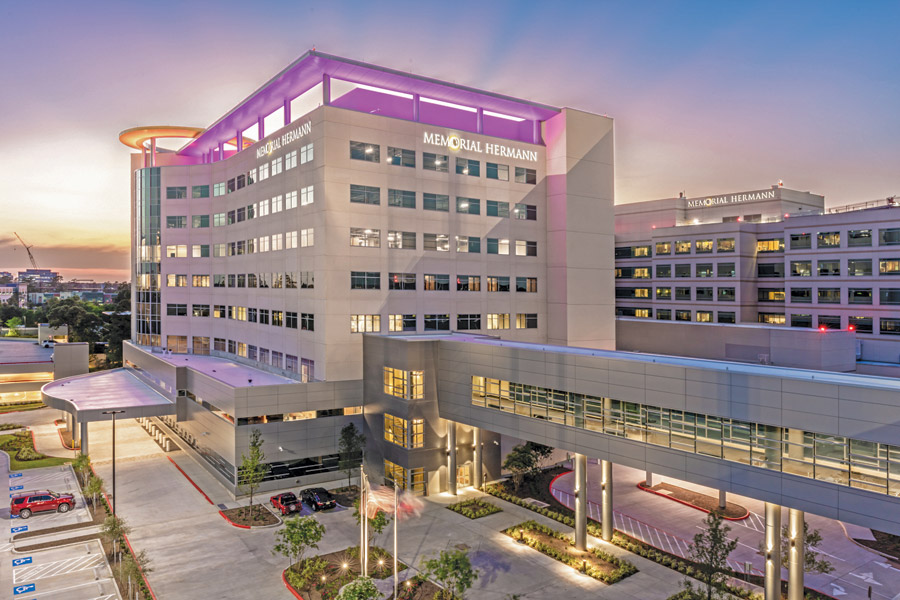
The Memorial Hermann The Woodlands South Tower and Garage project features a new 332,000-sq-ft concrete eight-story bed tower and two-story vertical expansion of the existing five-story precast parking garage.
Photo courtesy of Austin Commercial
“The combination of those projects winding down and a few projects starting slow in late 2020 and early 2021 due to the pandemic uncertainty are what caused the drop in 2021, and we see revenue increasing in 2022 as well,” says company President Larry Rooney.
In Oklahoma, improving market sectors include healthcare, infrastructure, tribal, K-12 and municipal, “specifically MAPS in Oklahoma City, and ARPA-funded projects still awaiting approval by the state legislature,” Rooney says. And in North Texas, “corporate relocations are continuing a strong office market. Several municipalities have passed bonds, the state of Texas passed another round of project funding for universities, and those projects are entering the market,” he adds.
Manhattan’s heavy civil and infrastructure businesses continue to see a large amount of work in Oklahoma, Arkansas and Mississippi, Rooney adds. “All three of these states have robust plans to upgrade their transportation networks with projects funded by strong state budgets, but also funds from the federal infrastructure bill,” he says.
Webber LLC, based in The Woodlands, Texas, saw regional revenue drop by $120 million in 2021, posting $1.02 billion in revenue as it discontinued operations of its commercial division and sold SCC Materials, its materials division, both of which only operated in Texas, says the firm’s president and CEO Jose Carlos Esteban.
Esteban noted that on Jan. 1, Ferrovial Services North America became the infrastructure division of Webber, adding that the company also is developing an energy division that will focus on construction of solar plants.
Webber is currently leading work on the $341-million IH 35 McLennan County in Waco and the $301-million Loop 12 Reconstruction in Irving.
The release of federal funds for construction and reconstruction of infrastructure projects will bring new opportunities for Webber and other heavy/civil contractors across Texas and other geographies, Esteban says. Webber’s new energy division would also benefit from the “85 GW ($90 billion) of utility-scale solar projects [in Texas] seeking interconnection into the grid before 2026,” he adds.
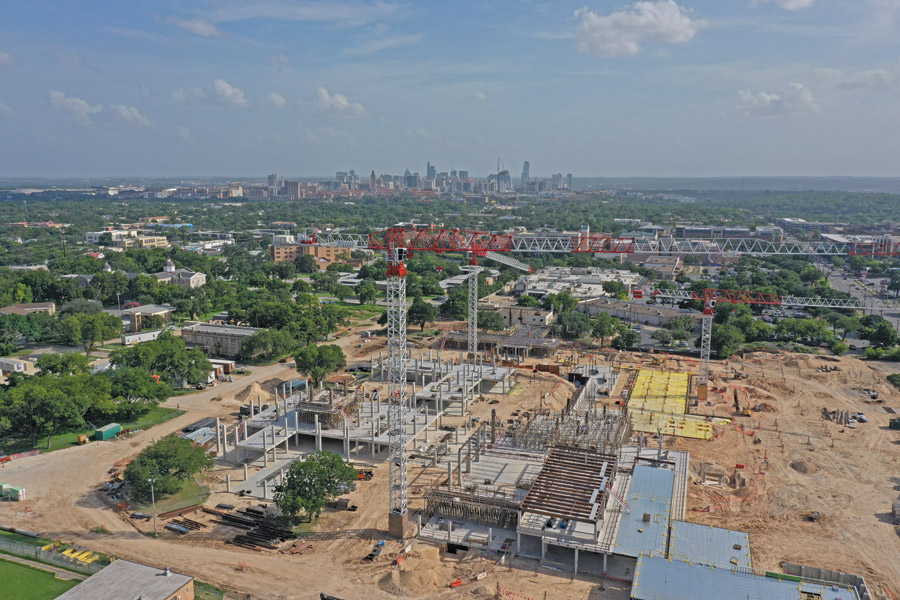
A bird’s eye view of structural steel erection on building two at Logistix Hub, South Dallas, a 1 million-sq-ft cross-dock distribution facility.
Photo courtesy of MYCON General Contractors
Tracking Upward
Among the firms who saw revenues rise last year was Dallas-based Austin Industries, which reported a $338-million regional gain for 2021, up to $1.79 billion. That increase was mostly due to two major drivers, says Chris Guice, vice president of marketing and business development at one of the firm’s three operating companies, Austin Commercial.
Among Austin’s four offices in the ENR Texas/Louisiana region, “we had several projects go on hold during the pandemic,” Guice explains. “Those projects have since picked up over the last year, driving our regional revenue up.”
The other driver was an uptick in the region’s advanced technology market over the past year. “This has benefited Austin dramatically, as the advanced technology market is one Austin Commercial has a long history of success in,” he adds.
The company saw a record backlog year for its Houston office, thanks to the $172-million Memorial Hermann The Woodlands South Tower and Garage that was completed in Q1 2022, the $74-million University of Houston John M. O’Quinn Law Building that is nearing completion, and a slate of projects underway for MD Anderson Cancer Center.
“Coming out of the pandemic, Austin Commercial is placing a higher level of focus on incorporating prefabrication and Lean principles on all of our projects,” he adds.
“Our greatest concern at this point is inflation and the effect it may have on projects.”
—David Taylor, President and COO, S&B Engineer and Constructor Ltd.
Healthcare represents another market seeing growth in the region, Guice says. “As cloud-based growth continues to expand across the region, the data center market has continued to see great demand, driving the market higher post-pandemic,” he adds. “Both the industrial—big box and cold storage—and multi-family are still very active across the region.”
Also on the rise was Houston-based Satterfield & Pontikes Construction Inc., up $71 million in 2021 to report $720 million in regional revenue.
“As part of a strategic plan to broaden the markets we serve, we pursued diverse markets that have long-term opportunities and that match well with our core competencies,” says senior vice president John Marshall. “With greater diversification comes greater strength and sustainability, and S&P is focused on providing opportunities for several generations of constructors to come.”
The education, multi-family and warehouse/distribution sectors have been especially strong for S&P, he adds.
Meanwhile, Dallas-based Turner Construction Co. saw its regional revenue climb by about $130 million to post a total of roughly $835 million for 2021.
“Although we have seen a dip in commercial construction due to escalation, inflation and overall cost, we did see in an increase in the demand for health care, industrial and mission-critical,” says Nick Barker, vice president and general manager of North Texas at Turner. “Those markets continued to grow even during the pandemic.”
Turner is leading work on the replacement facility for Austin State Hospital, as well as the $300-million University of Oklahoma (OU) Medical Center | Adult Bed Tower, which is the largest hospital expansion project in Oklahoma history, according to the firm.
Nearby, Bob Moore Construction, based in Grapevine, Texas, posted an $88-million gain in regional revenue to reach $200 million in 2021, thanks to both existing and new clients investing in new construction despite rising materials costs and supply chain delays, says the firm’s executive vice president Mark Duvall.
“We have continued to see substantial growth in the industrial sector,” Duvall adds. “The rising cost and lead time of materials continues to be a concern, across the board.”
On the plus side, to date the firm hasn’t had any clients cancel or delay any projects due to pricing or supply chain-related issues, he adds. “We have been able to work with clients during the pre-construction process and provide estimates that give clients a reasonable expectation on price and alert them to fluctuating material costs,” Duvall says.
Dallas-based MYCON General Contractors Inc. grew by $78 million in 2021 to post $295.5 million in regional revenue “due to the rise in demand for industrial construction, along with our diverse portfolio,” notes company CFO Malynda Dickinson.
Market sectors the firm sees improving in 2022 include self-storage, industrial and distribution centers, Dickinson says. “The office market is lagging but starting to show momentum, while retail renovations have increased and ground-up construction is projected to improve in another 12 months.”
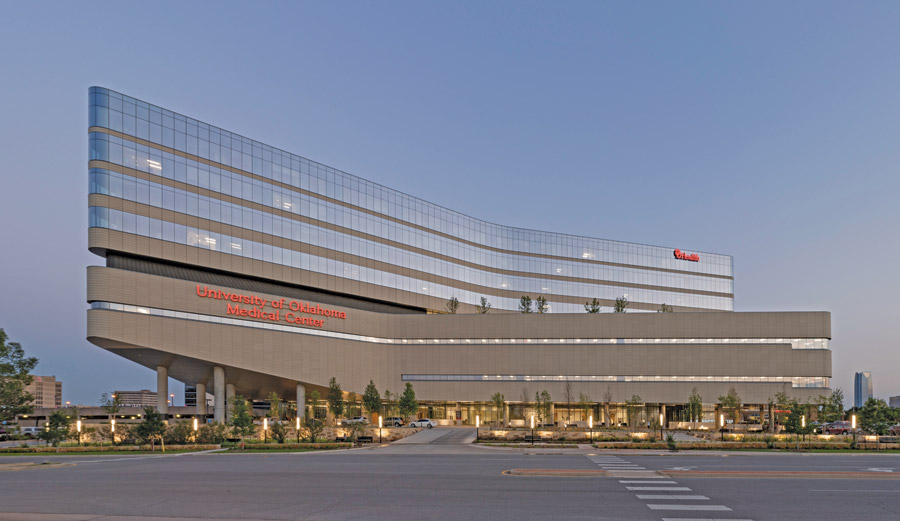
The University of Oklahoma (OU) Medical Center | Adult Bed Tower - The eight-story North Tower will provide 144 additional beds and 32 new operating rooms.
Photo courtesy of Turner Construction Co.
Looking Ahead
The greatest challenge to the construction industry is uncertainty, Marshall says. “Whether that is supply-chain related, workforce-related or any other variable in the construction equation,” he adds. “There are few things that are ‘givens’ right now. That places a premium on communication and collaboration. It also highlights the benefit of providing strong, technology-based planning and pre-construction.”
But a positive that has come out of the challenges surrounding materials and manpower is innovation, Barker says. “We have seen a very positive shift in the modular, prefabrication and innovative side of design and construction due to the manpower concerns.”
Rooney notes that Consumer Price Index (CPI) has dominated the recent news cycle, which is bringing greater attention by clients and designers to the industry’s supply chain and escalation challenges.
“While consumer inflation continues to cause significant headwinds, with West Texas Intermediate Crude up 34% year to date, key construction commodities we are tracking, including lumber, aluminum and copper, have begun to retreat from recent record highs,” he adds.
Taylor observes some improvements in the energy export markets, specifically natural gas and other petroleum products.
“Our greatest concern at this point is inflation and the effect it may have on projects,” Taylor adds. “A positive trend seems to be more growth despite the unpredictable inflation.”
But construction wage growth and labor availability are applying significant pressure to costs across the supply chain, Rooney explains.
“We are anticipating construction labor wages to closely track with the recent growth in CPI,” Rooney says. “We are still seeing supply chain challenges with HVAC equipment, cement and roofing products, while other segments are seeing lead times flatten out or reduced from record highs.”
